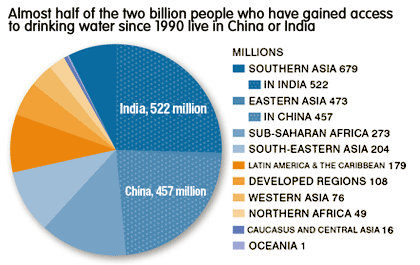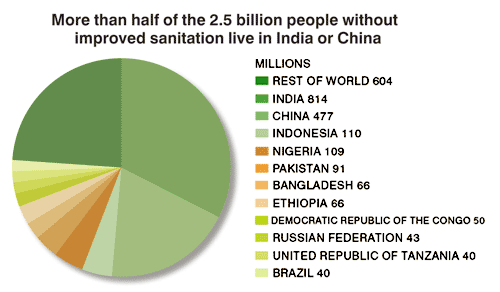- ON THE DECADE
- THE DECADE'S CAMPAIGN
- REPORTING ON PROGRESS
- THE DECADE'S PROGRAMMES
- FOCUS AREAS
-
- Access to sanitation
- Financing water
- Gender and water
- Human right to water
- Integrated Water Resources Management
- Transboundary waters
- Water and cities
- Water and energy
- Water and food security
- Water and sustainable development
- Water and the green economy
- Water cooperation
- Water quality
- Water scarcity
- FOCUS REGIONS
- RESOURCES FOR
- UN e-RESOURCES
Asia and the Pacific
The Asia-Pacific region comprises of the Member States of the United Nations Economic and Social Commission for Asia and the Pacific (UNESCAP) that includes 62 Governments, 58 of which are in the region and a geographical scope that stretches from Turkey in the west to the Pacific island nation of Kiribati in the east, and from the Russian Federation in the north to New Zealand in the south.
The region is extremely diverse, with seven of the world’s most populous countries and many of its smallest nations, several of which are located in the Pacific. Between 1987 and 2007, the region’s population grew from just under 3 billion to about 4 billion people. Average population density, at 111 people per km2, is the highest in the world.
Access to water
China and India alone recorded almost half of world’s progress, with increases of 457 million and 522 million, respectively since 1990. This is not surprising, however, since the inhabitants of these two countries represent 46% of the developing world’s population. Of note are the impressive gains in Eastern Asia, which added 23 percentage points, and the small decline in coverage in the Caucasus and Central Asia and in Oceania.
Number of people who gained access to improved drinking water sources from 1990 to 2010 by MDG region (millions)
When analysing the trends in the use of different types of water sources from 1990 to 2010, two clear groupings emerge. The first is a set of regions within the Asian and the Pacific region in which the use of piped water to a dwelling, plot or yard is low (30% or less). It includes Oceania, Southern Asia and South-Eastern Asia.
Although gains in the use of piped water on premises have been made in these regions, progress is mostly in the ‘other improved’ category of water sources. Of note is the fact that 65% of the populations in Southern Asia are using other improved sources rather than piped water on premises.
The second group consists of Eastern Asia and Western Asia, where at least 70% of the population are using piped water on premises. Eastern Asia (dominated by China) has seen a dramatic increase in piped water supplies since 1990, gaining 35 percentage points in coverage in this category in 20 years. Eastern Asia is also the region with the most dramatic increase in the use of improved drinking water sources overall, starting at 68% in 1990 and moving to 91% coverage in 2010. This represents a 23 percentage-point increase, far higher than any other region.
Though they are on track to reach the target, China and India combined are still home to 216 million people without access to improved water supplies. This represents 28% of the global population that remains unserved.
Access to sanitation
Many countries are off track in meeting the MDG sanitation target, including several of the most populous countries in Asia. The greatest progress was achieved in Eastern which added 39 percentage points in coverage between 1990 and 2010. Unlike drinking water, no regions have experienced decreases in coverage and Southern Asia, where sanitation coverage in 2010 was 1.7 times higher than in 1990. In contrast, progress was slowest in Western Asia, and no improvement was achieved in Oceania over the 20-year period.
Progress in China and India is highlighted, since these two countries represent such a large proportion of their regional populations. While China has contributed to more than 95% of the progress in Eastern Asia, the same is not true for India in Southern Asia. Together, China and India contributed just under half of the global progress towards the MDG target in sanitation.
Southern Asia still struggle with low coverage of 41%. In Southern Asia, the proportion of the population using shared or unimproved facilities is much lower, and open defecation is the highest of any region. Although the number of people resorting to open defecation in Southern Asia has decreased by 110 million people since 1990, it is still practised by 41% of the region’s population, representing 692 million people. Open defecation is highest in rural areas of Southern Asia, where it is practised by 55% of the population.
Shared sanitation is predominantly an urban phenomenon which is most evident in Eastern Asia.
Number of people who use shared sanitation facility in Asia and the Pacific in 2010 (millions)
Asia and the Pacific hotspots
The many threats to water resources in the Asia-Pacific region reveal a complex picture and raise many concerns. The hotspots are countries, areas or ecosystems that have overlapping challenges such as poor access to water and sanitation, limited water availability, deteriorating water quality, and increased exposure to climate change and water-related disasters.
- Pakistan. In the summer of 2010, approximately one-fifth of Pakistan was inundated; affecting more than 20 million people in the flooded areas along the length of the River Indus. Flooding also destroyed more than 1.6 million acres of crops.
- South-East Asian countries. Although high economic growth rates provide finances for better water resources management, many current development priorities ignore the risks from natural disasters, climate change, and poor household water and sanitation access. For example, India is in danger of being ill-prepared for natural disasters and climate change, while unsustainable water-use patterns are evident in Pakistan and Uzbekistan. Basic access to sanitation remains a major concern for Bangladesh.
- India’s Punjab and the North China Plain. These are referred to as Asia’s major breadbaskets. Water tables in these areas are falling by 2 m to 3 m a year, with serious impacts on agriculture and food security.
- Water-rich countries, such as Malaysia, Indonesia, Bhutan and Papua New Guinea, are facing urban water supply and quality constraints. Domestic sewage is a particular concern because it affects ecosystems near densely populated areas. Approximately 150 to 250 million m3 per day of untreated wastewater from urban areas is discharged into open water bodies or leached into the subsoil.
Driving forces, pressures and challenges
The Asia-Pacific region is extremely dynamic, undergoing rapid urbanization, economic growth, industrialization, and extensive agricultural development. Although these are desirable trends in many ways, they also represent drivers that are affecting the region’s capacity to meet its socio-economic water development needs.
- Population growth and rural-urban migration
Internal migration and urbanization are driving the rise in the number of megacities. The region has some of the world’s fastest-growing cities and between 2010 and 2025 a predicted 700 million people will be added to the growing numbers requiring municipal water services.
- Economic development
Since 2000, the Asia-Pacific’s GDP growth rate has surpassed 5%. Agriculture consumes an average of about 80% of the region’s renewable water resources, but it is faced with the challenge of increasing food production in degraded ecosystems. In addition, the irrigation sector is generally inefficient, and demand-management mechanisms are ineffective where they exist. Water quality also suffers from the impacts of industrial development, urbanization and agricultural intensification.
- Water conflicts
Water competition has led to increased water conflicts in the region, particularly over the past two decades. Conflicts within countries have dominated since 1990, with more than 120,000 water-related disputes in China alone during this period. Water management efforts and resources in India often focus on ‘conflict management’ between different states. Direct conflict most commonly arises at the local level, and is often based on the construction of an ‘ill-thought-out’ dam, ambiguous water withdrawal rights or deteriorating water quality. The allocation of increasingly scarce water resources, however, is the principal cause of water conflicts, with the most important challenge in the region’s socioeconomic development being to balance different water uses and to manage their economic, social and environmental impacts. In water-stressed countries, there are competing demands for water for urban, industrial, agriculture and ecosystems upon which livelihoods depend. In addition, water disputes arise over inter-basin water transfers, which have environmental, social and financial challenges.
- Climate change and natural hazards
The Asia-Pacific is the world’s most vulnerable region with respect to natural disasters, which undermine economic development to varying degrees. Increased climate variability and extreme weather conditions are expected to severely affect the region, with floods and droughts predicted to increase in both magnitude and frequency. The Pacific’s small island developing states (SIDS) are particularly vulnerable to environmental natural hazards such as tropical cyclones, typhoons and earthquakes turning into disasters. One major tsunami or tropical cyclone can negate years of development effort.
Progress so far
Between 1990 and 2008, significant achievements were made in meeting the MDG on access to safe drinking water. But progress has generally been slower in providing improved sanitation, except in North-East and South-East Asia.
On safe drinking water, Asia and the Pacific region as a whole appears to have been doing well owing to the good performance of a few countries. Indeed it is an early achiever. Unfortunately, this disguises the fact that of the 48 countries with sufficient data to calculate a trend, 20 are off track. This is reflected in diverging trajectories between countries. Thus in the early 1990s Viet Nam, Mongolia and Myanmar had similar levels of access, but while Viet Nam is an early achiever and Mongolia is on track, Myanmar is making only slow progress. Nevertheless, most off-track countries could reach the target by increasing their access rates by less than 2 percentage points per year; only Lao PDR and Papua New Guinea require more. About 480 million people still lacked access to improved water resources in 2008.
For sanitation, progress has been slower with 1.9 billion still lacking access to improved sanitation in 2008. In the early 1990s, of the 48 countries for which trend data are available, 18 countries were offering basic sanitation to less than half their populations. Since then only four of these countries have made satisfactory progress: Viet Nam and Myanmar have reached their targets and Lao PDR and Timor-Leste are on track. A total of 30 countries in the region are off track. Nevertheless, nine of these countries could reach the target by extending access by less than one percentage point per year. Other countries including India require greater acceleration – though if India did meet the target another 290 million more people would gain access. Even when access is established, natural disasters and functionality levels can significantly influence whether or not drinking water and sanitation systems can continue to respond to the region’s needs. The Asia-Pacific is highly vulnerable to extreme events and climate change is expected to increase climate variability and the magnitude and frequency of floods and droughts.
Did you know?
- The Asia-Pacific is home to 60% of the world’s population but it has only 36% of its water resources. Per capita water availability is the lowest in the world.
- Between 2000- 2009, an average of 20,451 people were killed by water-related disaster excluding victims of tsunamis.
- The population practising open defecation in South-eastern Asia decreased from 141 million in 1990, to 83 million in 2008.
- The number of people using a shared sanitation facility in South-eastern Asia increased from 16 million in 1990, to 25 million in 2008.
- India provided more than 166 million people with access to sanitation since 1995. That is more people than the population of Japan and the Canada combined!
UN initiatives which are helping to raise the issue...
- Human values in Water, Sanitation and Hygiene Education Programme (HVWSHE)
UN-Habitat has implemented the HVWSHE programme, as part of the Water for African and Asian Cities Programmes, to impart information on water, sanitation and hygiene and also inspire and motivate learners to change their behaviour and adopt attitudes that promote hygienic living and wise and sustainable use of water.
- The Mekong Region Water and Sanitation (MEK-WATSAN) Initiative
The Mekong Region Water and Sanitation (MEK-WATSAN) Initiative was formulated as a collaborative effort between UN-Habitat, the Governments of the Greater Mekong Sub-region and the Asian Development Bank (ADB). The objective of the MEK-WATSAN Initiative is to support the participating countries in the Greater Mekong Sub-region (GMS) attain their water and sanitation related Millennium Development Goals (MDGs).
- The Sustainable Cities Programme (SCP) - Asia
The Sustainable Cities Programme-Asia (SCP-Asia) provides a well-proven Environmental Planning and Management (EPM) process to help cities respond to these challenges. Since its launch in 1995, the programme has grown from an UN-HABITAT Chennai-city based initiative, testing ways to integrate environmental concerns into urban development decision-making, to become an Asia Regional Environmental Support Programme based in UN-HABITAT's Regional Office for Asia and the Pacific (ROAP). Today it provides capacity-building and institutional strengthening support to some 66 demonstration cities and their national partners in 10 countries.
- Water and Sanitation Program (WSP): Economic Sanitation Initiative-East Asia
The Economics of Sanitation Initiative was launched in 2007 with a WSP study from Southeast Asia. The groundbreaking study was the first of its kind to attribute dollar amounts to a country’s losses from poor sanitation. The report sparked public awareness and Government action in several countries. The ESI initiative was born as a response by WSP to address major gaps in evidence among developing countries on the economic impacts of sanitation.
- Water and Sanitation Program (WSP): Economic Sanitation Initiative-South Asia
The Economics of Sanitation Initiative (ESI) is a multi-country initiative of the Water and Sanitation Program (WSP). ESI was launched in 2007 as a response to address major gaps in evidence among developing countries on the economic aspects of sanitation. The study aims to provide evidence that supports sanitation advocacy, elevates the profile of sanitation, and acts as an effective tool to convince governments to take action.
- Water for Asian Cities
Launched at the 3rd World Water Forum on 18 March 2003, this UN-Habitat initiative is currently engaged in providing pro-poor water and sanitation spread over India, Nepal, P.R. China, Lao PDR, Vietnam, Cambodia, Indonesia and Pakistan. The initiative aims to support the cities in Asia and the Pacific region to meet the water and sanitation related MDGs by enhancing capacities at city, country and regional levels and creating an enabling environment for pro-poor investments to be channelled into the urban water and sanitation sector.
To know more
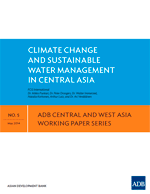 Climate change and sustainable water management in Central Asia
Climate change and sustainable water management in Central Asia
Asian Development Bank (ADB). May 2014
This working paper describes the results of research conducted in Central Asia. The research on Water and Adaptation Interventions in Central and West Asia combined field observations with satellite-based data and created models to demonstrate the impacts of climate change on the hydrology of the Aral Sea Basin. The paper is presented in three parts Assessing Climate Change; Impacts of Climate Change which explores these sub categories – Glaciers, Glacial Lakes, Water Resources, Future water Availability in Syr Darya and Amu Darya Basins, Floods, Permafrost and Slope Instability, Drying Environment; and concludes with Concrete Adaptation Options in Central Asia.
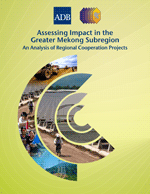 Assessing Impact in the Greater Mekong Subregion: An Analysis of Regional Cooperation Projects
Assessing Impact in the Greater Mekong Subregion: An Analysis of Regional Cooperation Projects
Asian Development Bank (ADB). April 2014
The Greater Mekong Subregion (GMS) consists of Cambodia, the People’s Republic of China (PRC, specifically Yunnan Province and Guangxi Zhuang Autonomous Region), the Lao People’s Democratic Republic (Lao PDR), Myanmar, Thailand, and Viet Nam. In 1992, with the assistance of the Asian Development Bank (ADB), the GMS countries launched the GMS Economic Cooperation Program to strengthen economic links between them. This study summarizes a recent major initiative to assess the initial impact of ADB-supported projects under the Greater Mekong Subregion Program.
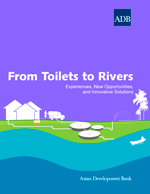 From Toilets to Rivers: Experiences, New Opportunities, and Innovative Solutions
From Toilets to Rivers: Experiences, New Opportunities, and Innovative Solutions
Asian Development Bank (ADB). March 2014
This publication showcases a compilation of project briefs culled from case studies of good practices, new approaches, and working models on sanitation and wastewater management from different countries in Asia and the Pacific. This compilation of good practices and working models intends to show that sustainable sanitation is possible, and aims to inspire replication, institutionalization of sanitation both in policy and practice, and scaling up of investments. Cases analyzed demonstrate solution options from which useful lessons can be derived and are presented under the following headings: (1) Improved On-Site Sanitation: A Business Case; (2) Decentralized Wastewater Treatment Systems for Public Markets and Peri-Urban Areas; (3) Constructed Wetlands with Reuse Applications. (4) Low-cost Sewerage Systems; (5) Applying Innovative and Multidimensional Approaches; (6) Wastewater as a Strategic Part of Economic Development; (7) Rethinking Financing Options; (8) Public-Private Partnerships: Driving Innovations; (9) Protecting Water Resources and Coasts; (10) Creating Synergies for Energy and Nutrient Recovery; (11) Wastewater and Septage Treatment and Reuse for Agriculture; (12) Wastewater Treatment and Aquaculture; (13) Wastewater Treatment for Sustainable Tourism and Recreation; (14) Environmental Sanitation and Good Governance.
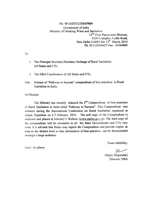 Pathway to Success. Compendium of Best Practices in Rural Sanitation in India
Pathway to Success. Compendium of Best Practices in Rural Sanitation in India
World Bank. March 2014
The 2nd volume of the Compendium of Best Practices on Rural Sanitation is a continuation of the 1st volume, titled ‘From Dreams to Reality’, released in 2010. The 16 success stories documented in this Compendium can be lessons of inspiration and serve as models for various Gram Panchayats, Districts, and States across India in overcoming hurdles and obstacles in rural sanitation in various fields as diverse as Community Participation, Sustainability, Resource Mobilization, Solid and Liquid Waste Management, Program Implementation, Information, Education and Communication Practices, and Institutional Reforms.
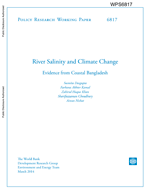 River Salinity and Climate Change: evidence from coastal Bangladesh
River Salinity and Climate Change: evidence from coastal Bangladesh
World Bank. March 2014
This paper presents a study conducted in Bangladesh, which quantifies the prospective relationship between climate-induced changes in sea level, temperature, rainfall, and altered riverine flows from the Himalayas, and the spread and intensity of salinisation on river water in the coastal zone by 2050. The research takes into account the projected land subsidence of the Ganges Delta, as well as alternative scenarios of upstream withdrawal of freshwater. The findings indicate that climate change will cause significant changes in river salinity in the southwest coastal area of Bangladesh by 2050. These changes are likely to lead to significant shortages of drinking water in the coastal urban areas, scarcity of water for irrigation for dry-season agriculture, and significant changes in the coastal aquatic ecosystems.
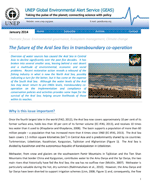 (The) future of the Aral Sea lies in transboundary co-operation
(The) future of the Aral Sea lies in transboundary co-operation
United Nations Environment Programme (UNEP). January 2014
This paper looks at the diminishing level of the Aral Sea and the multitude of economical, environmental and social problems this has caused. This is an interactive paper, with links to a video and interactive map as well as satellite images demonstrating the shrinking of the sea. The paper answers why this issue is important and provides the findings in support, demonstrating the status today plotted against previous years, the impacts and responses and concluding with the implications for policy.
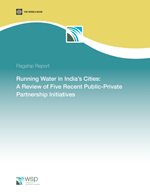 Running Water in India’s Cities: A Review of Five Recent Public-Private Partnership Initiatives
Running Water in India’s Cities: A Review of Five Recent Public-Private Partnership Initiatives
World Bank Water and Sanitation Programme (WSP). January 2014
This report provides a detailed assessment of five public-private partnerships (PPP) projects, in an effort to evaluate the underlying rationale of the initiatives; the preparatory and bid process; key contract provisions; risk allocation and related issues that may have a bearing on the operational trajectory; and impact of the achievement of objectives. The five projects, in Maharashtra, Karnataka and Madhya Pradesh, provide a detailed analysis of the process, politics and preparation of PPP projects in India. They represent all PPP initiatives in urban water supply undertaken in the country between 2005 and 2011; each case is represented clearly with lessons learned and conclusions.
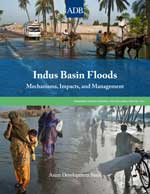 Indus Basin Floods: Mechanisms, Impacts, and Management
Indus Basin Floods: Mechanisms, Impacts, and Management
Asian Development Bank (ADB). October 2013
The Indus River is a major transboundary river in Asia with nine tributaries. More than 138 million people in the Indus River Basin in Pakistan depend on irrigated agriculture. But rising population pressures, climate change, and the continuous degradation of ecosystem services have resulted in increased flood risks, worsened by inadequate flood planning and management. This report proposes a holistic approach, applying scientific assessments that take people, land, and water into account. It also includes planning and implementation realized through appropriate policies, enforceable laws, and effective institutions.
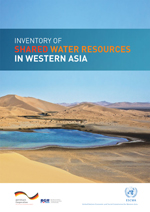 Inventory of Shared Water Resources in Western Asia
Inventory of Shared Water Resources in Western Asia
United Nations Economic and Social Commission for Western Asia (UNESCWA). September 2013
The Inventory of Shared Water Resources in Western Asia is the first effort led by the United Nations to catalogue and characterize transboundary surface and groundwater resources in the Middle East. The Inventory follows a standardized structure, with 9 surface water chapters and 17 groundwater chapters that systematically address hydrology, hydrogeology, water resources development and use, international water agreements and transboundary water management efforts. The chapters cover all rivers and groundwater resources shared between and by Arab countries in the Middle East.
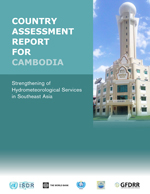 Strengthening of Hydrometeorological Services in Southeast Asia
Strengthening of Hydrometeorological Services in Southeast Asia
World Bank, United Nations Office for Disaster Risk Reduction (UNISDR), National Hydrological and Meteorological Services (NHMS), World Meteorological Organization (WMO). 2013
The Country Assessment Reports for Cambodia, Indonesia, Lao PDR, Philippines and Viet Nam investigate the capacity of the national hydrological and meteorological services (NHMSs) and recommend improvements through a regional approach. Initial assessments in the reports show the cost-effectiveness of strengthening national hydro-meteorological services through regional cooperation for reducing adverse impacts of natural hazard-induced disasters and climate change which know no national boundaries.
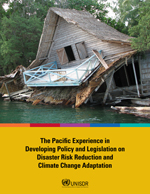 The Pacific Experience in Developing Policy and Legislation on Disaster Risk Reduction and Climate Change Adaptation
The Pacific Experience in Developing Policy and Legislation on Disaster Risk Reduction and Climate Change Adaptation
United Nations Economic and Social Commission for Western Asia (UNESCWA). September 2013
The purpose of this study is to contribute to the process towards developing the Pacific integrated regional strategy for disaster risk management and climate change by 2015, and the global consultations for a post-2015 framework for disaster risk reduction. It also aims to contribute to the discussions held at the 2013 Joint Meeting of the Pacific Platform for Disaster Risk Management and the Pacific Climate Change Round Table. The study explores the drivers and process to develop Joint National Action Plans on Disaster Risk Management and Climate Change, primary Disaster Risk Management (DRM) legislation, and sustainable development plans addressing DRR and Climate Change Action in selected Pacific island countries (PICs). It also briefly discusses the experiences so far in the implementation of these instruments. The three PICs included in this study are Cook Islands, Solomon Islands and Tonga.
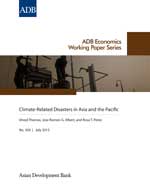 Climate-Related Disasters in Asia and the Pacific
Climate-Related Disasters in Asia and the Pacific
Asian Development Bank (ADB). July 2013
This document explores whether there is a statistical relationship between changes in climate variables such as temperature and precipitation and the frequency of intense natural disasters. The paper is structured as follows. Section II sets out a framework for analysis, based on the IPCC’s disaster risk framework, focusing on the key idea that natural disaster risk is affected by hazards, exposure to those hazards, and vulnerability to their effects. Section III presents an overview of natural disaster data and trends globally, and in Asia and the Pacific. It notes that the overall trend of increasing disasters is largely due to greater frequency of intense hydrometeorological events (floods and storms), rather than geophysical events. Section IV uses the disaster risk framework presented in Section II to examine how the risks of intense climate-related disasters in Asia and the Pacific might be connected to demographic factors, socioeconomic and environmental degradation, and climate anomalies. Section V complements the regional review with a description of the likely impact of climate and disasters in the Philippines. The final section presents some implications.
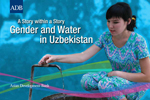 A Story within a Story. Gender and Water in Uzbekistan
A Story within a Story. Gender and Water in Uzbekistan
Asian Development Bank (ADB). July 2013
This report provides a summary of the water supply and sanitation situation in Uzbekistan in relation to gender issues and main achievements in ADB’s projects addressing the gender issues related to water supply and sanitation.
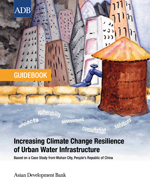 Guidebook: Increasing Climate Change Resilience of Urban Water Infrastructure. Based on a Case Study from Wuhan City, People’s Republic of China
Guidebook: Increasing Climate Change Resilience of Urban Water Infrastructure. Based on a Case Study from Wuhan City, People’s Republic of China
Asian Development Bank (ADB). June 2013
This guidebook, based on a case study from Wuhan City, People’s Republic of China, bridges the gap between the theoretical analyses of climate change impact on the urban water sector and the planning decisions that municipal authorities and utility managers need to make to increase the sector’s climate change resilience. It answers questions that city planners and managers globally currently ask regarding the effects of climate change, particularly on services and utilities, and what we can do to prepare for these. The guide presents steps to determine both Wuhan’s vulnerability to the impact of climate change and the opportunities to improve its resilience. The solutions proposed are presented as a program of investment decisions, which the city government and utility planners and managers could consider to increase the city’s resilience to the effects of climate change. It focuses on answering the questions currently being asked by city planners and managers all over the world, as follows: What changes might be caused by climate change? How will these affect services and utilities? What can we do now to prepare for them?
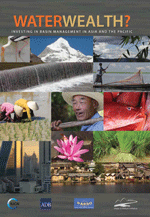 WaterWealth? Investing in Basin Management in Asia and the Pacific
WaterWealth? Investing in Basin Management in Asia and the Pacific
Asian Development Bank (ADB), International Union for Conservation of Nature (IUCN). March 2013
This publication highlights how people work together in Asia and the Pacific to secure water for all through innovative approaches in basins. Drawing on a cross-section of 43 case studies prepared specially for this publication, WaterWealth explains the challenges to improving water governance and management across Asia and the Pacific region. It illustrates many examples of new approaches and practices already being applied by basin managers to secure water for all.
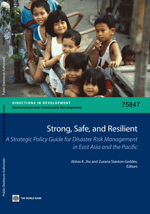 Strong, Safe, and Resilient: A Strategic Policy Guide for Disaster Risk Management in East Asia and the Pacific
Strong, Safe, and Resilient: A Strategic Policy Guide for Disaster Risk Management in East Asia and the Pacific
World Bank. March 2013
This publication provides a brief overview of the key issues, strategic goals, and recommendations for disaster risk management (DRM) in East Asia and the Pacific. Chapter one gives an overview of the key trends related to disaster impacts in the region. Chapter two focuses on cross-sectoral issues of institutional arrangements for DRM and outreach to communities. Chapter's three to seven follow the core areas of DRM: risk identification, risk reduction, emergency preparedness, financial protection, and sustainable recovery and reconstruction. The appendixes include additional information related to specific sections of the report, a glossary of key terminology, and a summary of the main activities of the World Bank East Asia and the Pacific disaster risk management team. Drought and floods are addressed all along the report.
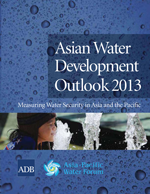 Asian Water Development Outlook 2013. Measuring Water Security in Asia and the Pacific
Asian Water Development Outlook 2013. Measuring Water Security in Asia and the Pacific
Asian Development Bank (ADB). March 2013
This second edition of the Asian Water Development Outlook (AWDO) provides a quantitative and comprehensive view of water security in the countries of Asia and the Pacific. By focusing on critical water issues, AWDO 2013 provides finance and planning leaders with recommendations on policy actions to improve water governance and guidance on investments to increase their country's water security. AWDO 2013 is presented in three parts.
- Part I introduces the five key dimensions of water security and presents the combination of indicators for assessment of national water security. The assessments for individual countries are aggregated to provide regional snapshots, with overviews of what the findings mean, identifying regional issues and hot spots where urgent action is required to improve water security.
- Part II applies the indicators to demonstrate how countries in Asia and the Pacific measure up against the AWDO vision of water security, discusses what is at stake, and introduces policy levers that may be used to increase security in each key dimension. It summarizes a series of background papers and analyses that underpin this edition of AWDO.
- Part III presents a summary of policy and strategic actions to increase water security, synthesized as key messages to assist political, water sector, and civil society leaders guide actions on water security nationally, in river basins, and in communities.
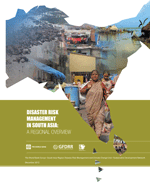 Disaster Risk Management in South Asia: A regional overview
Disaster Risk Management in South Asia: A regional overview
World Bank Global Facility for Disaster Reduction and Recovery (GFDRR). December 2012
This report informs readers about the elements that are driving increases in disaster risk in the South Asia Region (SAR). The report first examines the regional rise in disaster events and losses, the nature of the hazards, the drivers of current and future disaster loss, and provides an overview of activities that can reduce the vulnerability of exposed assets. A more detailed profile of each of the major hazards in SAR is then provided in Annex 1. Finally, Annex 2 examines the Disaster Risk Management (DRM) profile of each country in the region. These include the hazard profile, the DRM framework for each country, the progress made in reducing vulnerability to hazards, and ongoing activities to increase resilience that are being financed by the international community.
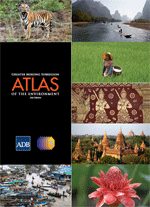 Greater Mekong Subregion Atlas of the Environment. 2nd edition
Greater Mekong Subregion Atlas of the Environment. 2nd edition
Asian Development Bank (ADB). December 2012
In 1992, Cambodia, the People’s Republic of China, the Lao People’s Democratic Republic, Myanmar, Thailand, and Viet Nam established the Greater Mekong Subregion (GMS) Economic Cooperation Program with the aim of strengthening economic linkages between them and to foster the achievement of common policy goals. This second edition of the atlas illustrates the diversity of the subregion’s natural environment, progress made by the GMS countries over the past decades, and the need to address the increasing risks that they face.
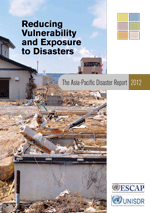 The Asia-Pacific Disaster Report 2012: Reducing Vulnerability and Exposure to Disasters
The Asia-Pacific Disaster Report 2012: Reducing Vulnerability and Exposure to Disasters
United Nations Economic and Social Commission for Asia and the Pacific (UNESCAP), United Nations International Strategy for Disaster Reduction (UNISDR). October 2012
The Asia-Pacific Disaster Report 2012 provides an analysis of the impact of disasters on Asian and Pacific countries between 1970 to 2011, and discusses the twin challenge faced by the region of increasing exposure of its people and economic assets, and heightened vulnerabilities experienced by the poor and other disadvantaged groups to disasters. Pressures resulting from rapid urban development and economic growth has resulted in people and economic activities expanding into increasingly exposed and hazard-prone land. It also highlights that smaller economies, those that have less diversified economic structures, and countries with high fiscal deficits, show greater strains of vulnerability even when faced with relatively small-scale disasters. The Report discusses how the poor or most vulnerable are often at risk, as they are increasingly forced to live in fragile or hazardous areas. Several recommendations are made on how to reduce this growing exposure and vulnerability including the need to strengthen the socio-economic evidence base for more informed policy making and enhanced integration of disaster risk reduction into broader development issues, a minimum level of universal social protection and improved land use planning.
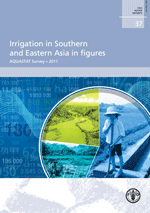 Irrigation in Southern and Eastern Asia in figures. AQUASTAT Survey – 2011
Irrigation in Southern and Eastern Asia in figures. AQUASTAT Survey – 2011
Food and Agriculture Organization of the United Nations (FAO). August 2012
This AQUASTAT report presents the most recent information available on water resources and their use in the 22 countries of the Southern and Eastern Asia region, and analyses the changes that have occurred since the first AQUASTAT survey in 1999. It gives a more detailed description of four transboundary river basins in the region, highlighting the different levels of cooperation and the agreements between countries located in the same river basin: the Ganges–Brahmaputra–Meghna basin, the Indus basin, the Mekong basin and the Salween basin.
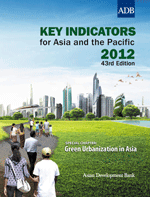 Key indicators for Asia and the Pacific 2012. Special chapter: Green Urbanization in Asia
Key indicators for Asia and the Pacific 2012. Special chapter: Green Urbanization in Asia
Asian Development Bank (ADB). August 2012
This special chapter of the report “Key indicators for Asia and the Pacific 2012” focuses on the environmental challenges Asia faces as it urbanizes. It begins by highlighting special features of Asia’s urbanization. The chapter then discusses the environmental challenges associated with urbanization, covering topics such as access to water and sanitation, loss of natural ecosystems, and urban slums and poverty. Before concluding, the chapter offers a number of evidence-based policy options that can help achieve a win-win scenario of urban growth with improvement in the environment.
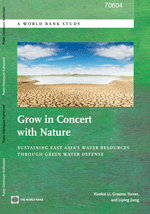 Grow in Concert with Nature. Sustaining East Asia's Water Resources through Green Water Defense
Grow in Concert with Nature. Sustaining East Asia's Water Resources through Green Water Defense
World Bank Water Partnership Program (WPP). June 2012
This study assesses advances in management practices, institutional and technological innovations for managing water scarcity sustainably under a changing climate. The report has the following specific objectives, reflected in the structure of the report: 1) To provide a brief overview of the status of water resources in East Asia, including the diversity of climates, the extent of physical water scarcity and potential changing climate impacts; 2) To summarize major management measures being implemented in selected countries where water is, or has the potential to become scarce, and how they fit in the green water defense concept; 3) To document key lessons learned from best practices in managing scarce water resources from experiences in the country case studies; and 4) To provide a roadmap for East Asian countries to apply the GWD approach in addressing water scarcity issues and improving water security.
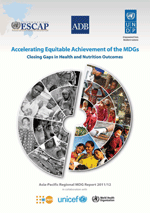 Accelerating Equitable Achievement of the MDGs. Closing Gaps in Health and Nutrition Outcomes. Asia-Pacific Regional MDG Report 2011/12
Accelerating Equitable Achievement of the MDGs. Closing Gaps in Health and Nutrition Outcomes. Asia-Pacific Regional MDG Report 2011/12
Asian Development Bank (ADB), United Nations Development Programme (UNDP), United Nations Economic and Social Commission for Asia and the Pacific (UNESCAP). February 2012
This report focuses on disparities in MDG achievement within and between countries, to address major bottlenecks holding back MDG progress in Asia and the Pacific region. This edition looks especially at the wide gaps in the goals related to health and nutrition, where the region is particularly under-performing. The safe drinking water and basic sanitation targets are also considered and reported. The document is a resource which policy makers, development practitioners and other stakeholders should find useful in addressing the remaining challenges in achieving the MDGs in the Asia and the Pacific region.
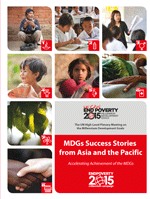 MDGs Success Stories from Asia and the Pacific. Accelerating Achievement of the MDGs
MDGs Success Stories from Asia and the Pacific. Accelerating Achievement of the MDGs
United Nations Development Programme (UNDP). 2010
This publication is a compilation of success stories and good practices from Asia and the Pacific, collected by the United Nations Millennium Campaign as its contribution to the MDG Review process in September 2010 in New York. It includes 15 short case studies, which feature innovative and successful regional initiatives which have made tangible impact on the MDGs. Each case study attempts to answer the following three questions: What has worked? Why? How can it be scaled up or replicated effectively elsewhere? Sanitation is specifically covered in case “Improved Sanitation in Cambodia” and the issue of access to water is addressed in case “Grow to Feed – Improving Food Security”.
Sources:
- Accelerating Equitable Achievement of the MDGs-Closing Gaps in Health and Nutrition Outcomes. Asia-Pacific Regional MDG Report 2011/12. UNESCAP, 2012
- Achieving the Millennium Development Goals in an Era of Global Uncertainty. Asia-Pacific Regional Report. UNESCAP, ADB, UNDP, 2010
- Global Environment Outlook 4. UNEP, 2007
- Managing Water under Uncertainty and Risk. The United Nations World Water Development Report 4, Vol. 1.UNESCO, March 2012
- (The) Millennium Development Goals Report 2012. United Nations, July 2012
- Population Dynamics: Social Development in Asia-Pacific. UNESCAP, 2011
- Progress on Drinking Water and Sanitation. 2012 update. UNICEF/WHO JMP, March 2012
- (A) Snapshot of Drinking-Water and Sanitation in the MDG region South-eastern Asia-2010 Update. WHO, UNICEF, August 2010
- (A) Snapshot of Sanitation in South Asia with focus on inequalities. Fourth South Asia Conference on Sanitation (SACOSAN-4) 4-7 April 2011. Colombo, Sri Lanka. WHO, UNICEF, 2011
- State of Environment in Asia and the Pacific 2005 Synthesis. UNESCAP, 2006
- Statistical Yearbook for Asia and the Pacific, 2009. UNESCAP, 2010
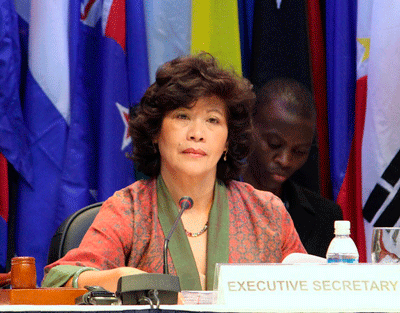
"Our shared challenge in Asia and the Pacific is to control both the growing rate of exposure and rising vulnerability. Exposure to hazards has multiplied as urban centres grow and people and economic activities expand into increasingly exposed and hazard-prone land. It is also a concern that smaller economies, those that have less diversified economic structures, and countries with high fiscal deficits, show greater strains of vulnerability even when faced with relatively small-scale disasters."
Noeleen Heyzer, UN Under-Secretary-General and Executive Secretary of UNESCAP
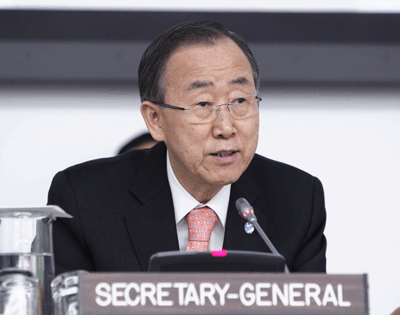
“Many cities are on the coasts, vulnerable to storms, inundation and sea level rise. More than a billion people in Asia live within 100 kilometres of the sea, and two-thirds of the population of Latin America and the Caribbean live within 200 kilometres. Too many people live on flood plains, others above earthquake fault lines. Some settle downstream from treeless areas, with little buffer against the elements. The risk of disaster quietly accumulates. And, while natural hazards menace everyone, the poor are by far the most vulnerable.”
Ban Ki-moon, UN Secretary General
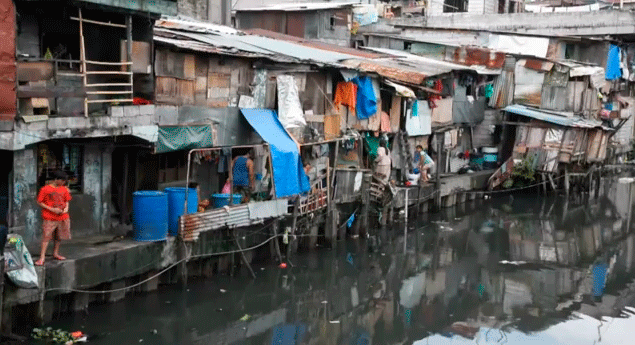
>>Sanitation for All: How do we get there? Asian Development Bank (ADB), 2011
Duration: 1min51sec Kickoff video shown during the opening ceremony of the “ADB and Partners Sanitation Dialogue: Making Sanitation Business” on 23 May 2011 in Manila, Philippines.
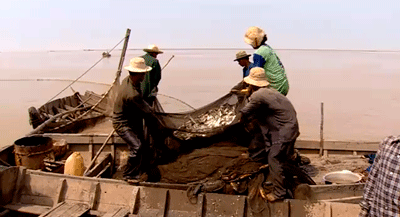
>>Water for All
Asian Development Bank (ADB), 2011
Duration: 2min02sec A video of Asia´s present water crisis and choice for improvement.
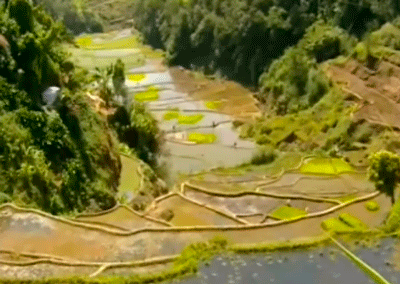
>>Asia Water
Asian Development Bank (ADB), 2010
Duration: 1min37sec Arjun Thapan, ADB´s Special Senior Advisor to the President on Infrastructure and Water, breaks down the principal, interrelated factors of Asia´s water crisis in this interview.

>>Bhutan: Tsunami from the Sky
UNTV 21st Century, 2010
Duration: 14min25sec
Bhutan In Bhutan, Himalayan glaciers are melting due to climate change, with lakes forming within the glaciers. Some of these glacier lakes are in imminent danger of bursting. This documentary explores the possible impacts on local livelihoods and adaptation measures being carried out in the region.
>> More videos on Asia and the Pacific on the Video Library
Copyright | Terms of use | Privacy notice | Site Index | Fraud alert | Help





